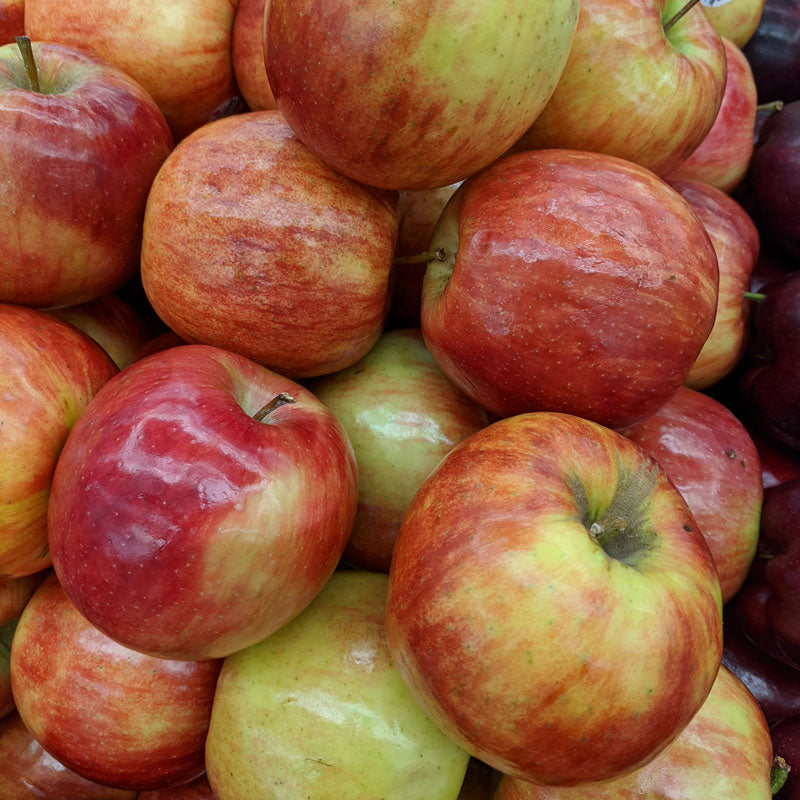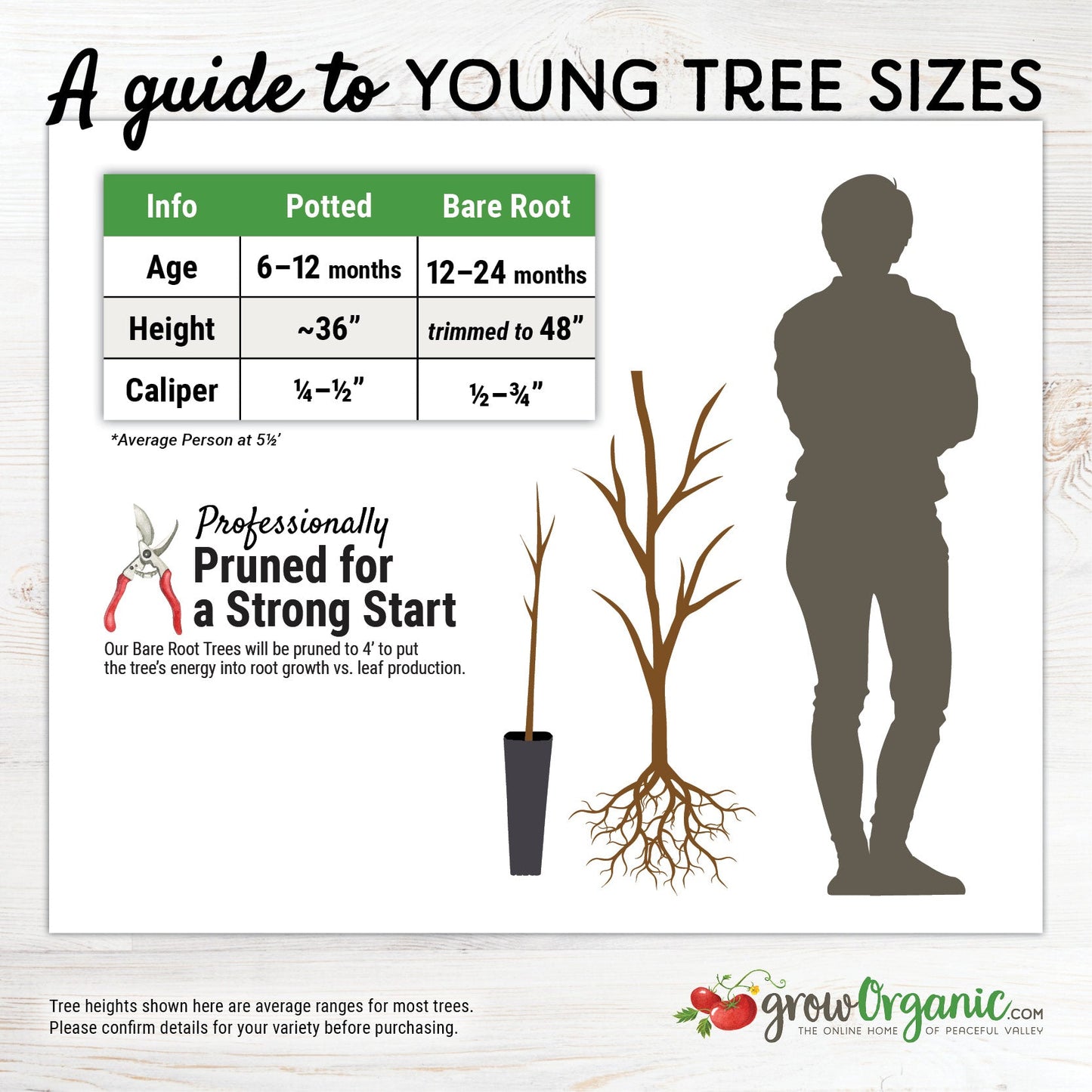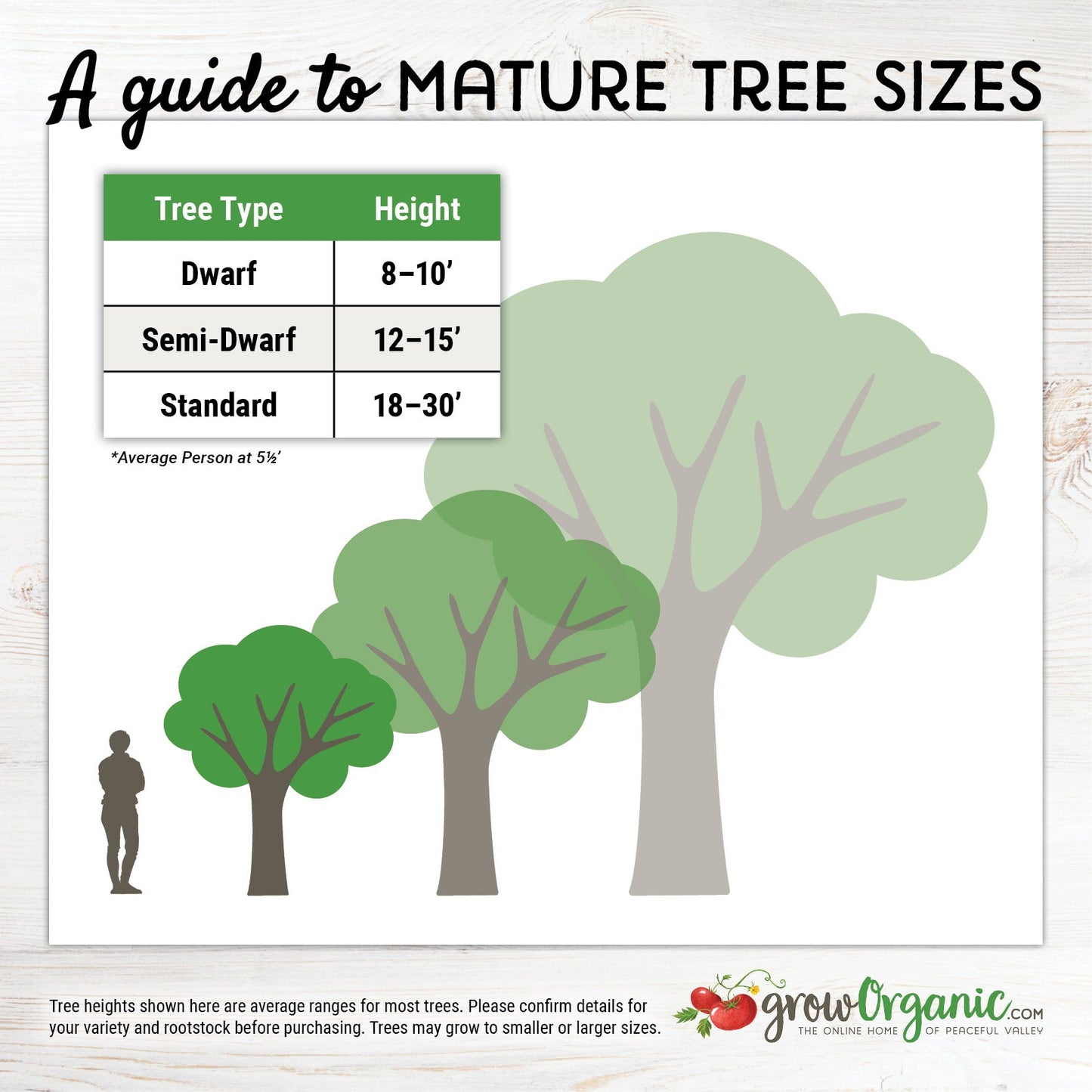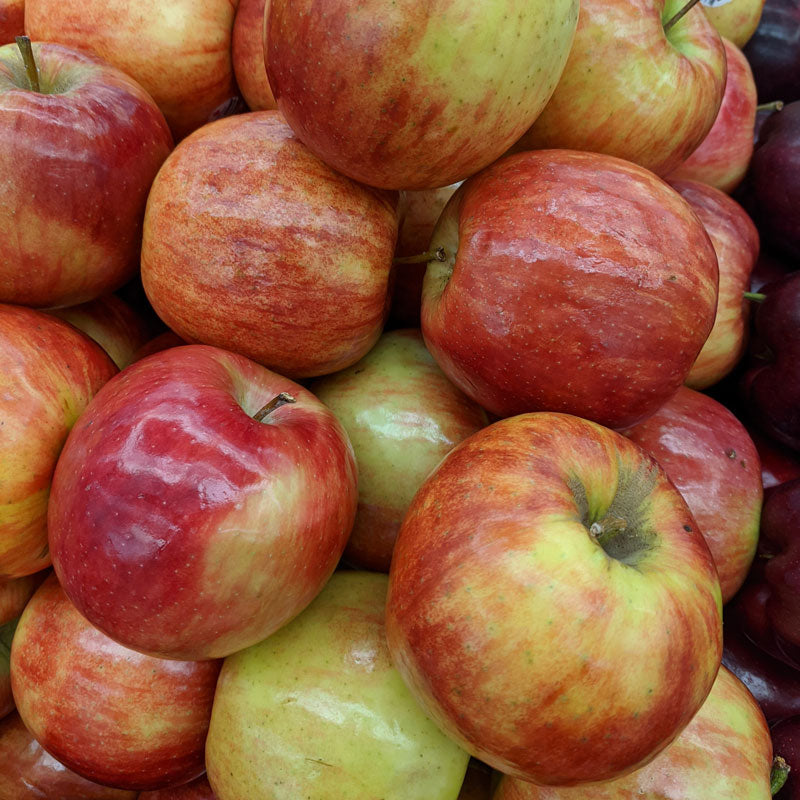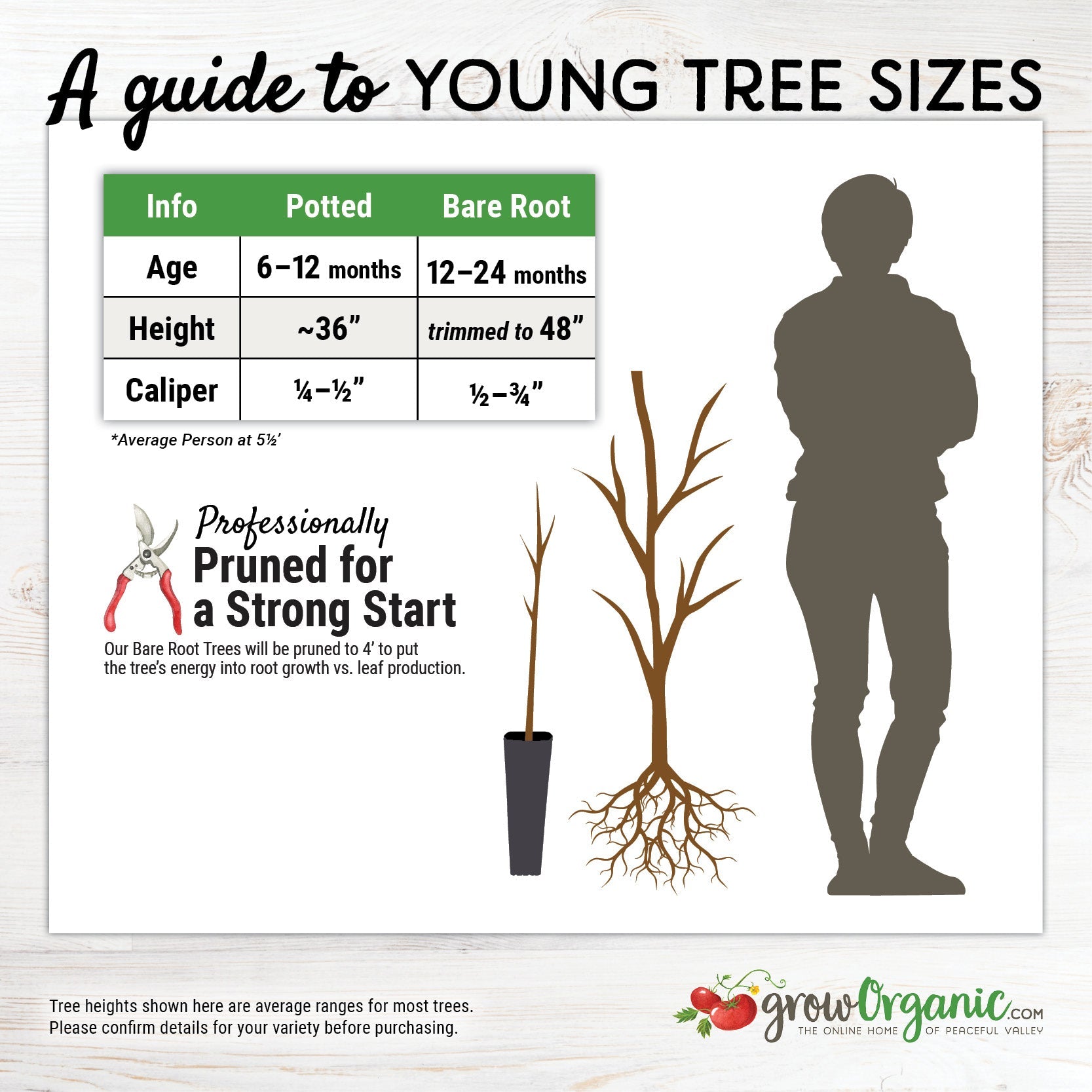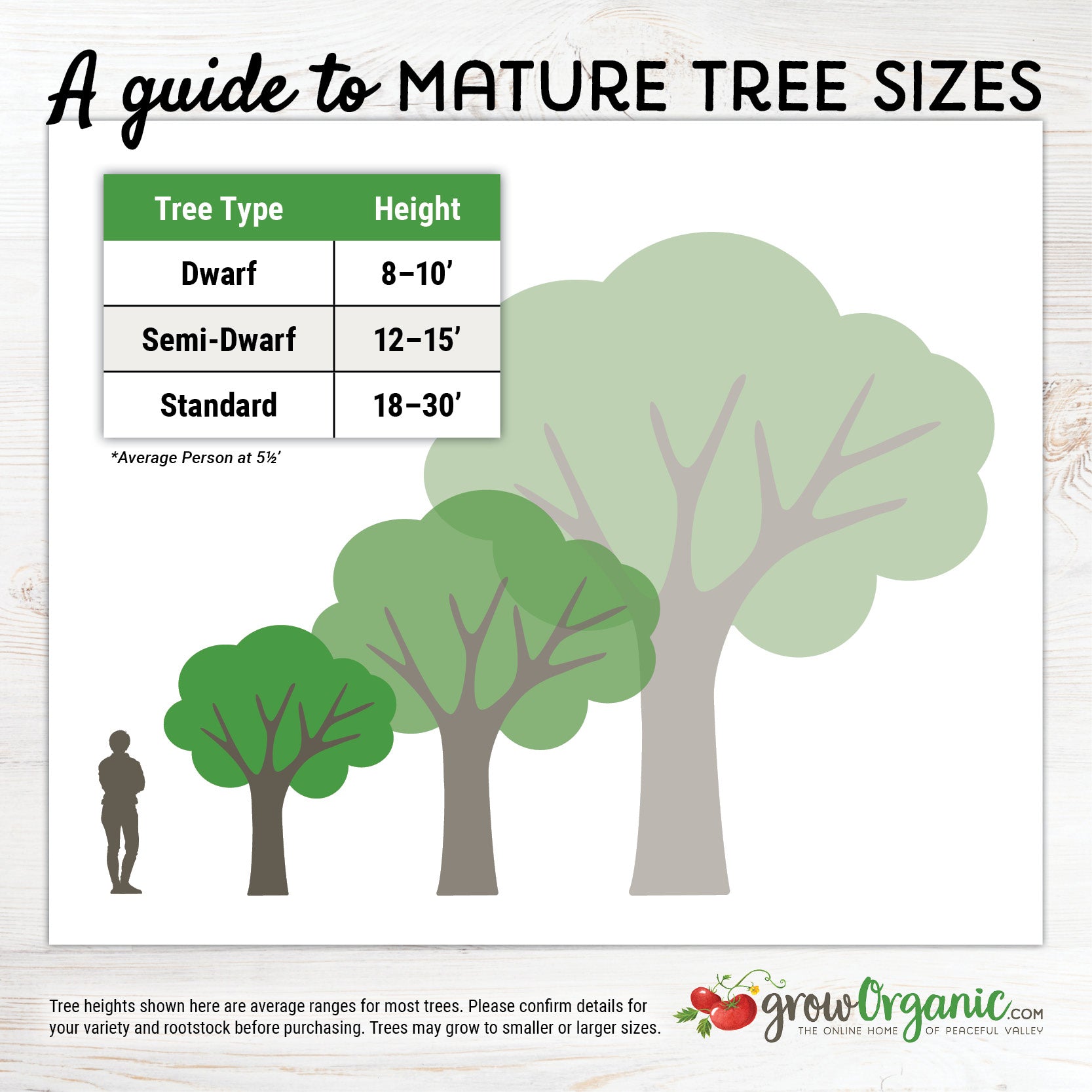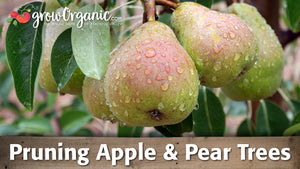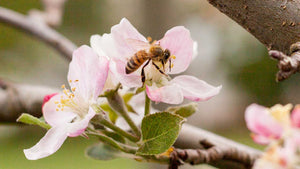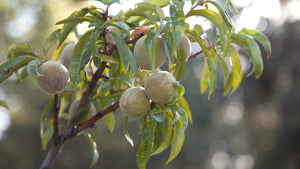Item Number: FT043
Honey Crisp Apple Tree
Honey Crisp Apple Tree
Super Sweet and Very Cold Hardy
Semi-dwarf on M111 rootstock
- Growing Zones: Suitable for USDA zones 3-9.
- Chill Requirements: Typically needs around 700-1000 chill hours for fruiting.
- Bloom Time: Usually blooms late, based on Central Valley California weather.
- Harvesting Dates: Honeycrisp Apples are usually harvested from early to mid-August.
- Looks: These apples have a striped red over yellow skin with white flesh that becomes mostly red with a pink cast in good light.
- Personality: They're characterized by their crisp and juicy texture with an aromatic flavor.
- Facts of Note: Honeycrisp Apples store well, have a sub-acid flavor, and were introduced by the University of Minnesota in 1990. They require heavy thinning.
- Pollinator: Requires a pollenizer. Varieties like Empire, Gala, Granny Smith, McIntosh, and Red Delicious can work well as pollinators.
- Ideal Soil Temperatures: Around 60°F to 80°F (15°C to 27°C) for optimal growth.
- Planting Depths: Plant young trees at the same depth they were growing in the nursery container.
- Germination Periods: Typically, these apple trees are grown from grafted trees rather than seeds. Germination isn't applicable.
- Height at Maturity: Grows to a height of about 15-20 feet (4.6 to 6.1 meters).
- Days to Maturity: Starts bearing fruit in about 2-3 years, with full production in 5-7 years.
- Sun/Shade: Honeycrisp Apples prefer full sun for optimal fruit production.
- Spacing After Thinning: Proper spacing is essential; maintain spacing of about 4-6 inches apart for healthy growth.
Visit our Fruit Tree Central for a listing of all our fruit tree videos and articles.
Visit Tree Characteristics for a listing of all our fruit & nut tree growing characteristics.
Honey Crisp Apple Tree
The Honey Crisp Apple Tree stands as a testament to exceptional apple cultivation, offering a delightful blend of sweetness, tartness, and crisp texture. Delving into the nuances of growing this apple variety unveils a process that ensures thriving trees and bountiful harvests.
Understanding Honey Crisp Apple Varieties:
Honey Crisp apples are revered for their crisp and juicy texture, making them an ideal choice for fresh eating. The striped red over yellow skin encases white flesh, with color variations influenced by light exposure during growth.
Suitable Growing Conditions: Thriving in Zones 3 to 9, these trees require approximately 700 to 1000 chill hours. They bloom late, aligning with typical Central Valley California weather. Adequate sunlight exposure and well-drained soil support their growth, ensuring healthy and vigorous trees.
Harvest Time and Characteristics:
The harvest window for Honey Crisp apples spans from August 3 to August 18. Their crispness, aromatic flavor, and sub-acid profile make them a sought-after choice for fresh consumption. These apples store exceptionally well, lasting for more than five months, maintaining their quality.
Root System and Growth Habits:
Semi-dwarf Honey Crisp Apple Trees, often grafted on M111 rootstock, exhibit a manageable size, reaching heights of about 15 feet. Their root system necessitates proper planting depth and adequate spacing to foster optimal growth.
Pollination and Pollenizers: Honey Crisp apples require a pollenizer for successful fruit production. Varieties like Empire, Gala, Granny Smith, McIntosh, and Red Delicious serve as suitable pollenizers, aiding in fruit set and yield.
Introduced by the University of Minnesota:
The Honey Crisp Apple Tree made its debut in 1990, introduced by the University of Minnesota. Known for its winter hardiness and vigorous nature, it requires heavy thinning to ensure quality fruit development.
Cultivation and Care:
Cultivating Honey Crisp Apple Trees demands attention to pruning, thinning, and disease prevention. Heavy thinning of fruit clusters promotes larger, more flavorful apples. Regular inspection for pests and diseases ensures the tree's health.
Flavor Profile and Culinary Uses:
Honey Crisp apples offer a delightful balance between sweet and tart flavors, appealing to various taste preferences. Their versatility extends to culinary uses, perfect for fresh eating, salads, desserts, and beverages.
The Honey Crisp Apple Tree, with its crisp texture, exceptional flavor, and storability, has become a favorite apple variety in the United States. Understanding its growth requirements and care ensures a continuous supply of these delicious apples, making it a prized addition to orchards and gardens.
Please Note: Although most of our bare-root trees arrive to our warehouse in mid-December, there are a few varieties that will not arrive until mid-January. If you order any of those varieties along with varieties that arrive in mid-December, your order will be delayed for shipment until mid-January. If you'd like us to split your shipments, please contact us at (888) 784-1722 or orderdesk@groworganic.com. Additional shipping charges will apply.


Check Your Zone Compatibility:
Compatible with your zone.
Growing Zone for
,

Our Guarantee To You
Since 1976, we've served our customers at every stage of growing. Please contact us at any time. We are happy to support and assist you.
Description
Description
Semi-dwarf on M111 rootstock
- Growing Zones: Suitable for USDA zones 3-9.
- Chill Requirements: Typically needs around 700-1000 chill hours for fruiting.
- Bloom Time: Usually blooms late, based on Central Valley California weather.
- Harvesting Dates: Honeycrisp Apples are usually harvested from early to mid-August.
- Looks: These apples have a striped red over yellow skin with white flesh that becomes mostly red with a pink cast in good light.
- Personality: They're characterized by their crisp and juicy texture with an aromatic flavor.
- Facts of Note: Honeycrisp Apples store well, have a sub-acid flavor, and were introduced by the University of Minnesota in 1990. They require heavy thinning.
- Pollinator: Requires a pollenizer. Varieties like Empire, Gala, Granny Smith, McIntosh, and Red Delicious can work well as pollinators.
- Ideal Soil Temperatures: Around 60°F to 80°F (15°C to 27°C) for optimal growth.
- Planting Depths: Plant young trees at the same depth they were growing in the nursery container.
- Germination Periods: Typically, these apple trees are grown from grafted trees rather than seeds. Germination isn't applicable.
- Height at Maturity: Grows to a height of about 15-20 feet (4.6 to 6.1 meters).
- Days to Maturity: Starts bearing fruit in about 2-3 years, with full production in 5-7 years.
- Sun/Shade: Honeycrisp Apples prefer full sun for optimal fruit production.
- Spacing After Thinning: Proper spacing is essential; maintain spacing of about 4-6 inches apart for healthy growth.
Visit our Fruit Tree Central for a listing of all our fruit tree videos and articles.
Visit Tree Characteristics for a listing of all our fruit & nut tree growing characteristics.
Honey Crisp Apple Tree
The Honey Crisp Apple Tree stands as a testament to exceptional apple cultivation, offering a delightful blend of sweetness, tartness, and crisp texture. Delving into the nuances of growing this apple variety unveils a process that ensures thriving trees and bountiful harvests.
Understanding Honey Crisp Apple Varieties:
Honey Crisp apples are revered for their crisp and juicy texture, making them an ideal choice for fresh eating. The striped red over yellow skin encases white flesh, with color variations influenced by light exposure during growth.
Suitable Growing Conditions: Thriving in Zones 3 to 9, these trees require approximately 700 to 1000 chill hours. They bloom late, aligning with typical Central Valley California weather. Adequate sunlight exposure and well-drained soil support their growth, ensuring healthy and vigorous trees.
Harvest Time and Characteristics:
The harvest window for Honey Crisp apples spans from August 3 to August 18. Their crispness, aromatic flavor, and sub-acid profile make them a sought-after choice for fresh consumption. These apples store exceptionally well, lasting for more than five months, maintaining their quality.
Root System and Growth Habits:
Semi-dwarf Honey Crisp Apple Trees, often grafted on M111 rootstock, exhibit a manageable size, reaching heights of about 15 feet. Their root system necessitates proper planting depth and adequate spacing to foster optimal growth.
Pollination and Pollenizers: Honey Crisp apples require a pollenizer for successful fruit production. Varieties like Empire, Gala, Granny Smith, McIntosh, and Red Delicious serve as suitable pollenizers, aiding in fruit set and yield.
Introduced by the University of Minnesota:
The Honey Crisp Apple Tree made its debut in 1990, introduced by the University of Minnesota. Known for its winter hardiness and vigorous nature, it requires heavy thinning to ensure quality fruit development.
Cultivation and Care:
Cultivating Honey Crisp Apple Trees demands attention to pruning, thinning, and disease prevention. Heavy thinning of fruit clusters promotes larger, more flavorful apples. Regular inspection for pests and diseases ensures the tree's health.
Flavor Profile and Culinary Uses:
Honey Crisp apples offer a delightful balance between sweet and tart flavors, appealing to various taste preferences. Their versatility extends to culinary uses, perfect for fresh eating, salads, desserts, and beverages.
The Honey Crisp Apple Tree, with its crisp texture, exceptional flavor, and storability, has become a favorite apple variety in the United States. Understanding its growth requirements and care ensures a continuous supply of these delicious apples, making it a prized addition to orchards and gardens.
Please Note: Although most of our bare-root trees arrive to our warehouse in mid-December, there are a few varieties that will not arrive until mid-January. If you order any of those varieties along with varieties that arrive in mid-December, your order will be delayed for shipment until mid-January. If you'd like us to split your shipments, please contact us at (888) 784-1722 or orderdesk@groworganic.com. Additional shipping charges will apply.
Apples are generally late blooming. Need full sun, well-drained soil, and moderate fertility. Thin fruit to maximize quality and size. Susceptible to codling moth, apple scab, powdery mildew, and gophers. Requires a pollenizer. Empire, Gala, Granny Smith, McIntosh and Red Delicious are good choices. Browse all our apple trees for sale.
Please Note: Although most of our bare-root trees arrive to our warehouse in mid-December, there are a few varieties that will not arrive until mid-January. If you order any of those varieties along with varieties that arrive in mid-December, your order will be delayed for shipment until mid-January. If you'd like us to split your shipments, please contact us at (888) 784-1722 or orderdesk@groworganic.com. Additional shipping charges will apply.
Shipping Information
Shipping Information
Cannot ship to the following states: HI, AK, PR, GU, VI
Cannot ship via USPS.
Cannot ship via SmartPost.
Shipping Weight: 5.0 lb
Dimensions: 55.5"L x 7.3"W x 2.75"H
Features
Features
- Flavor Pick
- Good Keeper
- Suited to Cold Climates
Characteristics
Characteristics
Planting & Care
Planting & Care
Useful Information
Useful Information
Guarantee
Guarantee
Limited Dormant Tree & Plant Guarantee
* Claim deadline is June 15th
We guarantee that your dormant tree or plant will arrive in good, viable condition. If your tree arrives in substandard condition, notify us within 3 days of delivery. Please email pictures of the box, inside packaging, the tree and its roots to helpdesk@groworganic.com. We will investigate your claim and process a request to exchange or refund the damaged product.
If your dormant tree or plant has not grown new leaves by June 15th, you may be eligible for our Limited Dormant Tree & Plant Guarantee. This guarantee provides for a store credit for the purchase price of the tree, excluding shipping. Please see the Instructions below.
Important Dates:
- April 1st Dormant trees/plants must be planted in the ground
- May 15th Perform scratch test, if no new leaves have grown
- June 15th Deadline to apply for a dormant tree/plant credit
All required documentation must be received by June 15th for your claim to be considered. Claims or documentation received after June 15th will be denied, without exception. Instructions listed below
Terms and Conditions
We cannot guarantee that your tree or plant will remain alive and healthy after it is received, or bear fruit as there are too many variables in your environment that are beyond our control (i.e. soil preparation, weed and pest control, proper irrigation, chill hours, compatible hardiness for your growing zone, proper choice of pollinator, extreme weather, rodent damage, disease, etc.).
We cannot guarantee that we will be able to provide a replacement tree/plant of the same species either that same growing season or in future years. Customers are responsible for all shipping fees associated with replacement trees and plants.
If we determine that the tree you purchased directly from us is not viable, we will issue you a store credit (not a refund) for the purchase price of the affected dormant tree or plant. Shipping is not included in the dormant tree/plant guarantee. Store credits can be used to purchase any product we sell and are valid for use only until July 1st of the following year.
Historically, 98% of our dormant trees and plants grow and thrive when they have been cared for and planted using our growing guides. Dormant trees and plants must be planted in the ground by April 1st in order to be eligible for credit. If the ground in your area is still frozen solid, you may temporarily plant your tree or plant in a pot.
Potted, non-dormant trees or plants are excluded from this guarantee as they are not dormant at the time of shipment. Evergreen trees such as citrus, avocado and olive trees are not available for credit under the Dormant Tree and Plant Guarantee.
Instructions
We guarantee that your dormant fruit tree or plant will leaf out, if you care for it according to our growing guides. In the unlikely event that your dormant tree or plant does not have leaves by May 15th, follow these simple steps to apply for a store credit:
Before you call or email, please perform a “scratch test” to determine if the tree or plant is still alive. This video shows how to check for live tissue under the bark. Scratch tests need to be done a few inches above and below the graft.
Green Cambium Layer / Living Trees
If the cambium layer under the bark is green, give your tree a little more time. It is still alive, but hasn’t come out of dormancy yet. Check to make sure that it is getting the right amount of deep root water, enough sunlight and that the weather is warm enough for that type of tree/plant to come out of dormancy. Every tree has its own personality and will come out of dormancy at different times. Be sure to submit the required documentation listed below by June 15th, if it doesn’t grow leaves.
Brown Cambium Layer / Dead Trees
If the scratch test shows a brown cambium layer or if your dormant tree/plant doesn’t have leaves by June 1st, please email us at helpdesk@groworganic.com. All required documentation listed below must be received by June 15th for your claim to be considered. To be considered for the guarantee claim, all required documentation must be received by June 15th. Incomplete submissions will be denied.
Required Documentation
- Order number
- Name of dormant tree/plant and the quantity affected
- Photos of each tree or plant showing:
- The roots (tree or plant must be pulled out of the ground)
- The scratch test areas
- The entire tree/plant
We reserve the right to not issue credit for items that have already been replaced. We also reserve the right to require photographic evidence that the tree/plant was not killed by root rot, rodent or mechanical damage.
Share
